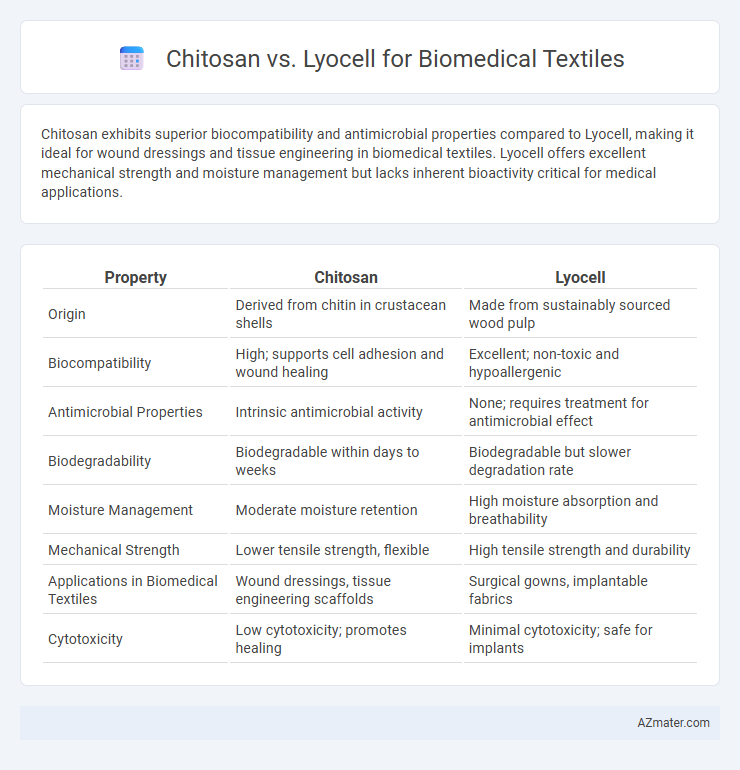Chitosan exhibits superior biocompatibility and antimicrobial properties compared to Lyocell, making it ideal for wound dressings and tissue engineering in biomedical textiles. Lyocell offers excellent mechanical strength and moisture management but lacks inherent bioactivity critical for medical applications.
Table of Comparison
| Property | Chitosan | Lyocell |
|---|---|---|
| Origin | Derived from chitin in crustacean shells | Made from sustainably sourced wood pulp |
| Biocompatibility | High; supports cell adhesion and wound healing | Excellent; non-toxic and hypoallergenic |
| Antimicrobial Properties | Intrinsic antimicrobial activity | None; requires treatment for antimicrobial effect |
| Biodegradability | Biodegradable within days to weeks | Biodegradable but slower degradation rate |
| Moisture Management | Moderate moisture retention | High moisture absorption and breathability |
| Mechanical Strength | Lower tensile strength, flexible | High tensile strength and durability |
| Applications in Biomedical Textiles | Wound dressings, tissue engineering scaffolds | Surgical gowns, implantable fabrics |
| Cytotoxicity | Low cytotoxicity; promotes healing | Minimal cytotoxicity; safe for implants |
Introduction to Chitosan and Lyocell in Biomedical Textiles
Chitosan, derived from chitin found in crustacean shells, offers exceptional biocompatibility, biodegradability, and antimicrobial properties, making it highly suitable for wound dressings and tissue engineering scaffolds in biomedical textiles. Lyocell, a regenerated cellulose fiber produced from wood pulp via environmentally friendly processes, provides high moisture absorbency, mechanical strength, and breathability, making it an ideal choice for medical textiles requiring comfort and skin compatibility. Both materials contribute unique biofunctional properties essential for advanced biomedical textile applications such as infection control, accelerated healing, and patient comfort.
Chemical Structure and Composition Comparison
Chitosan, derived from chitin, possesses a cationic polysaccharide structure characterized by repeating units of D-glucosamine and N-acetyl-D-glucosamine, enabling strong bioadhesive and antimicrobial properties ideal for wound dressings. Lyocell, a regenerated cellulose fiber, consists of b-D-glucose units linked by b-1,4 glycosidic bonds, offering high mechanical strength, biodegradability, and moisture-wicking capacity suitable for medical textiles. The chemical composition of chitosan provides unique biological functionalities through amine groups, whereas lyocell's cellulose backbone ensures structural stability and biocompatibility in biomedical applications.
Biocompatibility and Safety Profile
Chitosan exhibits excellent biocompatibility and antimicrobial properties, making it highly suitable for biomedical textiles aimed at wound healing and infection control. Lyocell, derived from cellulose, offers superior biocompatibility with minimal cytotoxicity and is valued for its high moisture absorption and skin-friendly characteristics in medical applications. Both materials present a strong safety profile; however, chitosan's biodegradability and inherent bioactivity provide additional advantages in regenerative medicine and tissue engineering.
Antimicrobial Properties of Chitosan vs Lyocell
Chitosan exhibits strong antimicrobial properties due to its polycationic nature, which disrupts microbial cell membranes, making it highly effective in biomedical textiles for infection control. Lyocell, a regenerated cellulose fiber, lacks inherent antimicrobial activity but provides excellent moisture management and comfort, often requiring chemical treatment or blending with antimicrobial agents to achieve similar effects. The superiority of chitosan in antimicrobial efficacy favors its use in wound dressings and infection-resistant medical fabrics compared to untreated lyocell.
Mechanical Strength and Durability
Chitosan exhibits excellent biocompatibility and antimicrobial properties but generally has lower mechanical strength and durability compared to Lyocell, which offers superior tensile strength and resilience under repeated stress. Lyocell fibers maintain structural integrity and durability in moist environments, essential for biomedical textile applications requiring long-term performance. The combination of Lyocell's robust mechanical properties with chitosan's bioactivity can optimize the functionality of biomedical textiles.
Moisture Management and Breathability
Chitosan offers exceptional moisture management due to its natural hydrophilicity and antimicrobial properties, promoting wound healing and preventing bacterial growth in biomedical textiles. Lyocell excels in breathability and moisture absorption thanks to its fine fibril structure, enabling efficient vapor transport and rapid drying. Combining chitosan's bioactivity with lyocell's high moisture retention and breathability creates advanced fabrics ideal for medical applications requiring comfort and hygiene.
Biodegradability and Environmental Impact
Chitosan and Lyocell offer distinct advantages in biomedical textiles due to their biodegradability and environmental impact. Chitosan, derived from shrimp shells, biodegrades rapidly through enzymatic action, minimizing environmental persistence and promoting wound healing with antimicrobial properties. Lyocell, produced from sustainably sourced wood pulp via a closed-loop solvent process, exhibits high biodegradability and low ecological footprint, making it an eco-friendly choice for medical textiles requiring durable yet biodegradable fibers.
Applications in Wound Healing and Tissue Engineering
Chitosan exhibits excellent biocompatibility, biodegradability, and antimicrobial properties, making it ideal for wound dressings that promote faster healing and reduce infection risk. Lyocell offers superior mechanical strength, moisture management, and biocompatibility, supporting tissue scaffolds and engineered constructs for cell growth and regeneration. Combining chitosan's bioactivity with lyocell's structural integrity enhances the performance of biomedical textiles in wound healing and tissue engineering applications.
Cost-effectiveness and Scalability
Chitosan offers promising biocompatibility and antimicrobial properties for biomedical textiles but faces higher production costs and scalability challenges due to its extraction from crustacean waste. Lyocell, a regenerated cellulose fiber, provides cost-effective large-scale manufacturing with consistent quality and eco-friendly solvent recovery processes, making it more scalable for mass biomedical textile production. The cost-effectiveness of lyocell combined with its renewable sourcing makes it a competitive alternative to chitosan for sustainable biomedical applications.
Future Prospects and Innovations
Chitosan's biocompatibility, biodegradability, and antimicrobial properties position it as a promising material for advanced wound dressings and tissue engineering in biomedical textiles. Lyocell, known for its sustainability, mechanical strength, and moisture management, is evolving with innovations like nanofiber composites and functionalization for enhanced cell adhesion and drug delivery. Future research is focused on hybridizing chitosan and lyocell fibers to combine their bioactive and structural advantages, driving next-generation smart biomedical textiles.

Infographic: Chitosan vs Lyocell for Biomedical textile
 azmater.com
azmater.com